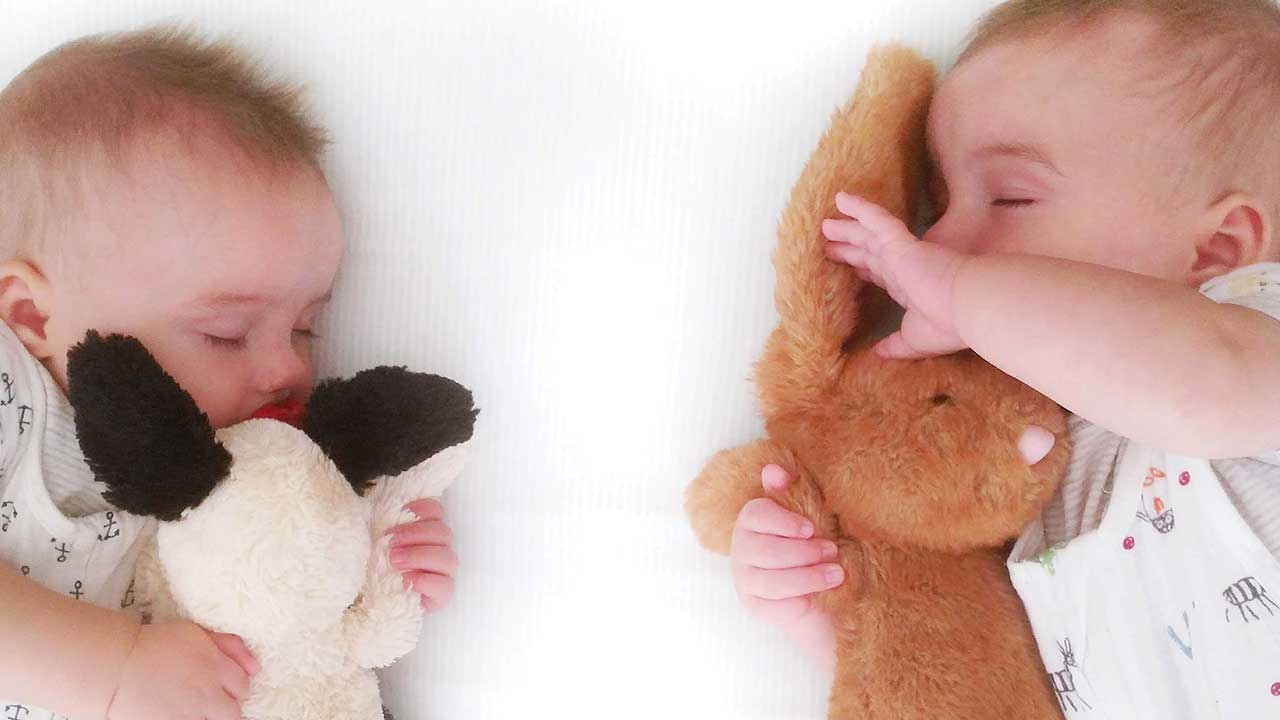Almost as soon as you give birth well-meaning parents are warning you about the four-month regression, and all the horror of 45 min to 2 hourly wakings overnight. It can seem like a lifetime away especially when you’re holding your beautiful snuggling newborn who is sleeping an impressive 16-20 hours in pleasant bursts during the day and night.
Your sleepy cherub? You can’t imagine it. However, the day will come when your tiny newborn grows into an impressively gorgeous chubby baby with lungs to match.
The four-month regression is a real thing, and it does impact all babies and their parents to varying degrees. It can strike anywhere between 8 to 20 weeks of age. It is entirely reasonable, natural and to be expected. Regression is the wrong word to use. A regression means to return to a former state, to go back to a time of less development.
Your baby is not going through a regression, but a progression into the next exciting stage of life. Your baby is developing and maturing their sleep cycles to become more like adults. There is absolutely nothing wrong with you or your baby if they suddenly start waking at all hours of the night. It’s not very pleasant for the parties involved, but it’s reasonable and solvable.

Table of Contents
What is it?
The four-month Regression is a maturing and development of your baby’s sleep cycles. It is when your baby who may have been previously sleeping 4 to 6-hour stretches at night starts to wake frequently. They might be up every 45 mins, every hour or every 2 hours. Whatever the timing the wake ups are frequent, exhausting and frustrating.
There is so much going on developmentally for your baby at this time: they are no longer a newborn, settling needs and wants can change, they’ll experience a growth spurt and look for more food, and of course those changing sleep cycles. All of these elements can come together to make sleep seem like a long distant memory.
Not only can night sleep become very disturbed, but daytime naps can also fall apart. All this disturbed sleep can lead to exhausted parents and an overtired baby which can then lead to even more wake ups. So far it all seems doom and gloom, but it’s just a normal stage of development that you can work through it.
Although all babies will experience their sleep cycles developing, not all babies will have night wake-ups or day time sleep difficulties. Some may sail straight through this period without too much bother at all. There are so many different factors to the four-month Regression that it can be a difficult one to navigate, but not impossible. Get knowledgeable, get prepared and get help if you need it or want it.
Sleep Cycles
When your baby was a newborn, they had a sleep cycle which would last from 45 to 50 mins in length. These cycles have two stages of sleep: active sleep and deep sleep. They spend 50% of their time in each stage of sleep.
Active sleep is similar to REM (rapid eye movement) sleep, which is where dreaming occurs for adults. While in this in this state your newborn might be quite noisy, move and twitch around a bit. It is why it can take 20 mins of settling time to help your newborn get to sleep, but then they are straight into a deep stage of sleep. Also, the reason why your newborn can happily sleep anywhere and everywhere.
Around four months of age, your baby develops, and their sleep cycles begin to run more like yours. They now cycle through 4 stages of sleep and REM sleep. It is why all manner of problems may arise. Your settling techniques no longer work as your baby needs your help for a much more extended period to settle to sleep.
Now they need to cycle through 2 stages of light sleep before heading into a deeper sleep. Then they suddenly wake up just after you put them down and you have to start all over again. They become more aware of these cycles, which is why they are easy to wake and disturbed when they have cycled back into a light stage of sleep.
Stage of Sleep Cycle from 4 Months
| Stage 1 – Non REM Sleep Nice and Relaxed | It is the beginning stages of sleep, and if you are awake during the stage, you probably won’t even think you were asleep. Your baby is also very quickly woken in this stage of sleep. There might be some muscle twitching and movement going on. |
| Stage 2 – Non REM Sleep Light sleeping | Also a light stage of sleep, but your child is asleep in this stage. Your baby’s body is preparing for a deep stage of sleep. During this stage your baby’s temperature begins to drop, their heartbeat slows, and the brain and muscles start to relax. It is easy to wake them up in this stage of sleep. |
| Stage 3 & 4 – Non REM Sleep Deep Sleep | Your baby is now in a deep stage of sleep and not easily woken. You can potter around them and not worry about waking them. Your baby’s body is now in repair mode. Muscles, bones, and tissues are getting fixed up and your babies immunity is strengthening, it’s a crucial stage of sleep to get too. |
| Stage 5 – REM Sleep Dreaming | It is a stage that you will start dreaming. Brain function in this stage is much like when your baby is awake, very active. |
This sleep cycle lasts from 90 to 120 minutes in length. It is why 2 hourly overnight wakings are, and this is when your baby has cycled back into Stage 1 of their sleep cycle. We all experience partial wake-ups during the night, but as adults, we are adept at getting ourselves back to sleep sometimes without evening noticing we woke. Your baby, however, may have difficulty getting back to sleep if they wake when cycling back into a light stage of sleep.

Contributing Factors
Growth Spurt
At around four months of age, babies can often experience a growth spurt and be looking for more food to support this fast growth stage. This growth spurt can perpetuate night wake ups as well as the change in sleep cycles.
Babies are very good at regulating their calorie intake, and if they are not getting enough calories during the day, they are going to wake for them at night. However, this doesn’t mean that a growth spurt is the cause of the sleep regression; it may just be a contributing factor or something to be aware of. Help your baby get all their milk needs during the day, so they don’t wake for other feeds during the night.
What can also happen here is your baby may get used to getting their milk needs at night and stop looking for them during the day. For example, your baby hits the four-month regression and starts to wake every 2 hours a night.
To help them go back to sleep, you feed them. They fall asleep, and everyone is happy. Except for mum who is up again in two hours to repeat the process. Then your baby starts getting a lot of their caloric milk needs met at night and begin to expect them here and doesn’t eat as much during the day, accidentally perpetuating the night waking problem.
It is also tricky because feeding to sleep is a very natural and a standard process particularly with a newborn. However, during this stage of development, it can be counterproductive, and the best way forward is to teach the baby how to self soothe, stick to a night feeding schedule and up feeds during the day.
Sleep Associations
Rocking, feeding, patting, swaddling, sleep sacs, dummies/pacifiers, and white noise is all sleep associations. Anything that your baby associates with going to sleep become a sleep association.
There are independent sleep associations and dependent sleep associations. Independent sleep associations are swaddling, sleeping bags, white noise, and a sleep approved lovely. Independent sleep associations are sleep aids that can be used independently by your baby.
Dependent sleep associations are rocking, feeding and patting to sleep. I don’t mean that these actions are wrong in any way, but they can become unsustainable in the long run because the parent has to be physically present during the night to provide their child with the sleep association they have become accustomed too.
You’re not a bad parent for rocking, feeding or patting your child to sleep. Newborns love all these associations, and they are good at helping them get to sleep. But as sleep cycles change at four months 10 to 20 minutes of rocking and patting can become 40 mins or more extended.
It is effortless to keep going with newborn-settling techniques when now your baby is older and has different settling needs. You can change these sleep associations when and where needed for more prolonged more sustainable sleep association which mean the whole family gets a good night sleep.
Unswaddled
Another reason for added disturbances at four months is the effects of unswaddling. Babies loved being wrapped up, but once they are rolling it is no longer a useful sleep tool, and it can be dangerous if your swaddled baby rolls onto their tummy.
Getting rid of the swaddle and moving to a sleep sack is a beautiful step forward. However, your baby’s newfound freedom may be a little disconcerting to start with. They will get used to their new spacious surroundings and enjoy finding their sleeping position.
Daytime Schedule
Have a look at your baby’s daytime schedule. It’s effortless not to realize that your little newborn is actually a big bouncing baby and they now need longer awakes times during the day. They become real social little beings and might get frustrated that you keep trying to put them down to sleep.
At four months, a baby can tolerate 90 to 120 minutes. Most babies are happy at four months with an awake window of closer to 120 mins. Extending their awake times during the day might help with their overall schedule end night sleep.
Another thing that will help to get night sleep back on track is helping your baby to consolidate their naps during the day with sleep training. At four months of age, we want to start seeing three naps a day. A short rest in the morning, a long midday nap and a quick catnap in the late afternoon are enough to help them get through to bedtime.
Focusing on consolidating and lengthening that midday nap and getting to bed nice and early is going to help combat your baby’s overtiredness. We are helping them to link those sleep cycles during the day and at night, so they can self soothe and get that lovely deep rested sleep their bodies need to develop, process information and strengthen their immunity.

Things That Can Help
Start a Dreamfeed
It is a great way to get some extra calories in and help your baby learn to sleep through the night. If your baby is 6.5 kgs, you can encourage them to sleep through the night with a dream feed. A dream feed won’t work before 16 weeks of age as your baby doesn’t yet have the physical size and ability to last until that morning feed.
A dream feed is where you pick your baby up while they are still sleeping, feed them and pop them back to bed without disturbing their slumber. It tops up their emptying tummies keeping them satisfied for longer. This feed is best given between 10 and 11 pm before you go to bed yourself.
The Best Environment for Sleep
A great way to ensure you are doing everything possible to minimize the effects of the 4 Month Regression is to make sure you have the optimal environment for sleep for both naps and night time. The best environment for sleep is:
Dark
I mean pitch black dark. Use heavy curtains, blackout blinds, put foil over the windows, anything that you can do to reduce as much light as possible. A dark room is the perfect setting to help stimulate the production of melatonin a hormone which helps us to sleep. While your newborn may not have minded the light during naps, your social four months will be very distracted by a lighter surrounding and have more difficulty falling asleep.
Temperature
The best temperature for sleep is 18 to 20 degrees. However, the idea is that your baby should be sleeping in a calm environment. Babies can die from overheating, so we want to ensure a pleasantly relaxed environment for sleep. A cold baby will wake to cry. Cold room temperature is safer and more comfortable for sleep.
White Noise
This is such a great tool to use from birth right up until your child is a toddler. The white noise should be played pretty loud at the start, louder than your baby’s crying. I’ve had mum tell me at; first, it can feel a little uncomfortable, but it works.
White noise is soothing for newborns, becomes a sleep cue for older babies and is excellent for masking outside noises from waking up your baby too early. You can have it playing all night to help your baby get back to sleep when they partially wake.
When I saw my boys stirring from a nap too early, I’d creep in and turn the white noise back on, and they would often settle back into sleep.
Wind Down Routine
A wind-down routine is important for your baby. Firstly, it helps them to calm down and get ready for sleep. Secondly, the different elements of your wind-down routine later become cues for your baby that it’s time to go to sleep.
A suitable wind-down method can take 10 to 20 mins depending on the needs of your baby. The more consistent you are, the quicker they will get at falling to sleep if you’re putting them down for naps at the right time.
- Darken the room ready for nap or bedtime. Use a lamp or hall light to see.
- Put the white noise.
- Swaddle or put your baby in their sleep sack.
- Spend some time cuddling, speaking softly, or signing to your baby.
- Lay them down in the cot and let them know it’s time for sleep.
- Do this consistently for every nap and bedtime, and your baby will soon learn that these steps mean that it is time for rest.
Sleep Training
No matter what you do, you still might have a baby that is struggling with this stage of development. Sleep training is a great way to help them learn to link sleep cycles, sleep independently and have positive sleep associations developing. Four months is the absolute earliest that you can start sleep training; they are only now developmentally ready to begin learning how to self-soothe.
The beautiful thing about starting to sleep train early is that gentle, hands-on, in-room methods work well at this age. If you are unsure about how to sleep train properly and the best way to use with your baby and your family seek out a baby sleep consultant or a sleep program, with steps you can follow and support you and your family during this time of change.
Have Confidence
Even if you are not feeling confident at all helping your baby get back to sleep or go down for bedtime, pretend to be satisfied for your baby. Your baby is so in-sync with you and if you head into their wind-down routine feeling anxious, stressed and frustrated your baby is going to feel that.
If you can take 10 minutes for yourself (easier said than done I know) put your baby in the swing for ten minutes, step outside have a big breath of fresh air or listen to 10 minutes guided meditation of your tube. Take some time to feel refreshed and then exude as much confidence and assurance as possible when settling or re-settling your baby to sleep.
To Prepare:
- Try to get great sleep habits happening with your newborn.
- Work on great settling techniques that your baby loves and prepare for changes.
- Create the right sleep environment.
- Work to age-appropriate daytime routines, looking out for changes.
- Look for signs for extra hunger and offer a second breast, more feeds or bigger bottles.
- Get some additional assistance around the house from a relative or friend.
Will every baby go through the 4 Month Regression?
Short Answer – No…
And yes! Don’t you hate those answers? Let me explain.
All babies will have a maturing and progression of their sleep cycles at around four months. This change will occur in all babies. However, not all newborns will be affected by wake ups every few hours overnight. If your baby slept well as a newborn, they might sail right through the period of development.
On the other hand, if you had a newborn who catnapped (taking only 45 mins naps) 4 to 5 times a day, you may experience the four-month regression and the others that follow. Although catnapping is ok for a newborn and they can get their sleep needs met, it’s not enough for a four-month-old, and they can begin to get overtired by not getting a long nap during the day. This overtiredness builds over months, and parents see the four-month regression starting at 5 or 6 months.
Don’t Feel Guilty
You are not a bad mother because your child is waking up; you’re not doing anything wrong. You haven’t failed in any way. It’s an entirely normal, albeit a frustrating and exhausting stage of development that all babies go through. It can be shocking if your baby previously slept well.
Don’t be swayed to start co-sleeping in the hope this may help, it’s just another sleep association you will have change at some point. It can also be an unsafe practice and led to less sleep for yourself and your partner.
Also, don’t feel guilty for wanting to sleep train your child. If you are seeking help, paying money, researching and looking for ways to help your baby, there is nothing wrong with this. A happy, well rested, well-slept mother is a great mother.
A mother who seeks help is a great mother, a mother who reads a sleep training book is a great mother, a mother who asks for extra help around the house is a good mother, a woman who is a mother who loves her child and wants the best for their child is a good mother. You are a good mother




